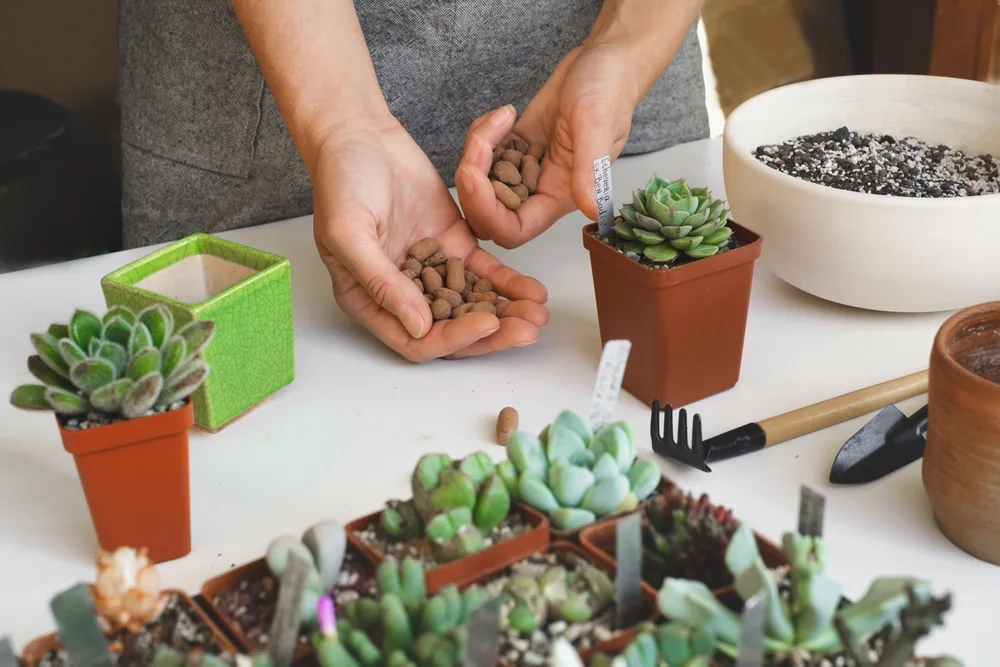If you’ve been growing plants in pots for a while, you might have heard that putting rocks at the bottom can improve soil drainage and prevent root rot. But does this method really work?

Despite the common advice to use gravel, pebbles, pottery shards, and rocks in plant containers to avoid soggy soil, research has shown that this practice doesn’t improve drainage.
In fact, that layer of gravel may cause even soggier soil, which can harm your plants. Here’s why you should avoid putting rocks in the bottom of your containers and some better ways to help your pots drain well.
Why Rocks for Drainage in Pots Don’t Work
At first glance, adding gravel to pots for drainage seems logical. You’ve seen rainwater run through gravel quickly while it pools in soil and creates mud.
It makes sense to think water would move faster through more porous materials like gravel. However, this isn’t the case when water has to first pass through a layer of soil.
Water doesn’t move easily between coarse gravel and fine potting mix materials.
When you water your plants, the water moves through the potting mix until it reaches the layer of gravel or rocks, where it stops moving.
Imagine placing a sponge on top of some gravel. If you pour water on the sponge, it will absorb the water, pulling it upwards against gravity.
Water trickles into the gravel beneath when the sponge is fully saturated.
In plant pots, the potting mix acts like a sponge, pulling water upwards and causing it to linger just above the gravel layer, creating a “perched water table.”
The potting mix only releases water to the gravel when it’s waterlogged and can’t hold more moisture. So, adding gravel or other materials at the base of your pots makes water linger around plant roots longer, increasing the risk of root rot.
How to Improve Soil Drainage in Pots
While gravel in the bottom of plant pots won’t improve drainage, there are other ways to ensure your plants don’t sit in soggy soil:
Choose the Right Pots:
Using planters with proper drainage holes is crucial for healthy plants. Even if your planters lack holes, you can create them using an electric drill with a masonry bit. To prevent soil from slipping out and making a mess, cover the drainage holes with a paper coffee filter or a small piece of screen mesh.
Amend Your Potting Mix:
Potting mixes contain materials like coarse sand, vermiculite, and perlite, which help with drainage. You can mix in more of these amendments to enhance the drainage of bagged soils. Adding extra compost to potting mixes also improves drainage.
Repot Your Plants:
Over time, potting mixes compact, slowing down water drainage. If you notice poor drainage, it may be time to repot your plants. Most tropical houseplants benefit from repotting every 12 to 18 months.
Good Ways to Use Gravel with Potted Plants
While gravel, pebbles, and rocks aren’t useful for drainage, they can still be beneficial for your houseplants or container garden in other ways:
Make a Pebble Tray:
Tropical houseplants often struggle indoors due to low humidity. To boost humidity, you can use extra gravel to create a simple pebble tray. Place pebbles in a flat tray or plate, add water until just below the top of the rocks, and then place a plant pot on the tray. As the water evaporates, it will add moisture to the air around your plant.
Keep Critters Out of Your Potted Plants:
Cats and squirrels can be a nuisance by digging in potted plants. A layer of pebbles on top of your potting soil can deter these animals, making the soil less pleasant for digging.
By following these tips, you can ensure your plants thrive without the need for rocks or gravel at the bottom of your pots.
